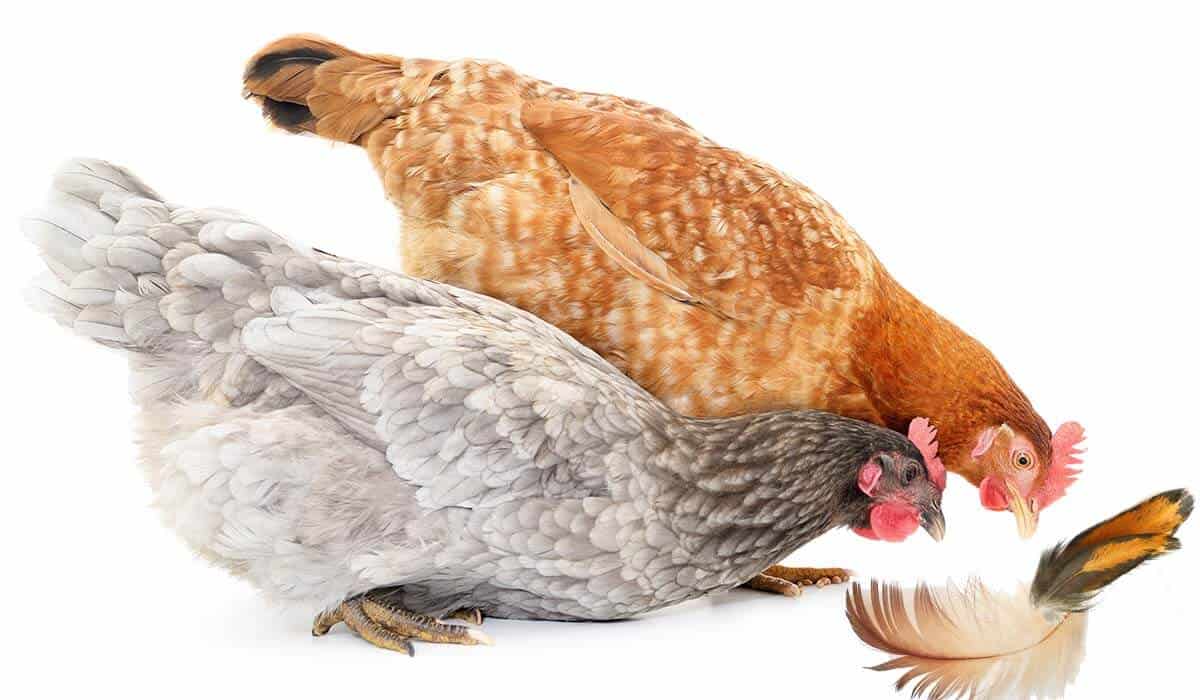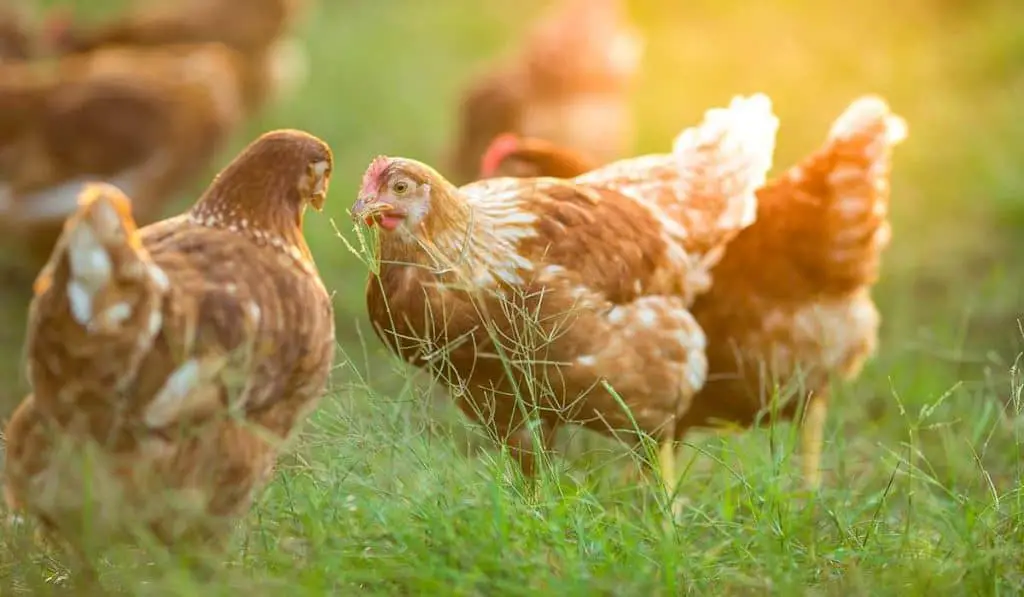You walk into your henhouse one day, checking on your chicken buddies seeing if they need anything. You find some hens having featherless patches all over them. Not only that, but you also find others having feathers in their mouths!
Why Do Chickens Eat Their Own Feathers? It could be they are molting and trying to remove the feathers quickly. Others are simply attracted to the color red and will peck their own feathers or some of the other’s chickens.
It can be a multitude of things, among which, it can be the herald of a cannibalism crime scene! But let’s not get ahead of ourselves, most of the time it’s completely normal?

Let’s take a closer look at what causes this behavior and what implications might that have?
*This page contains affiliate links to products I recommend. If you purchase something from this page, I may receive a small percentage of the sale at no extra cost to you.
The Difference Between Feather-Pecking and Feather-Plucking
Simply put, feather-plucking is when a chicken eats the feathers of its own body; while feather-pecking is when it eats the feathers of another’s. In feathers-plucking it doesn’t really eat them, it just pulls them out. In contrast, feathers-pecking is where there can be a whole lot of eating involved.
These two coexist in many situations, as they have a lot of the same causes. So let’s lump them in for now, and begin with talking about feather-pecking. This one can potentially lead to more serious consequences, and it’s more common among chickens.
What Is Feather-Pecking?
To know feather-pecking, let’s first start by differentiating it from bird preening, the peaceful pecking.
The Not-to-Worry-About Pecking
Usually, a pecking that’s carried out by the hen upon itself is just mere grooming that leaves no mark, it’s called bird preening, and that shouldn’t cause you any worries. This preening thing hugely differs from the aggressive feather-plucking previously mentioned.
So What Pecking Truly Is?
More often than not, when there is a pecking incident, there are two parties: A culprit, and a victim. As with any type of animal in the ecosystem, hens have a dominance hierarchy of their own. So if a hen is feeble, or a newcomer to the coop, chances are it’s going to get bullied!
The Easy Way of Solving the Problem, That Got Banned!
The traditional, easy way of solving this used to be beak-trimming. Beak-trimming is the partial removal or shortening of a bird’s beak. But it’s now banned according to the EU legislation.
Then what other solutions are there? Well, let’s first take a look not only at the motives of this crime, but at other things that could be mistaken for feather-pecking. So get your investigation gear and let’s dig deeper into that case!
What Else Could Be Causing the Same Signs of Pecking?

The signs for pecking could be false positives: Sometimes there is a lot more to it than meets the eye. When you see bald patches, redness, and even bleeding, this all can indicate a number of things, not only pecking.
The Annual Molt
One occurrence that has the same bald areas character is the annual molt. Here is where the chickens take a page out of the snakes’ playbook: Chickens shed their old feathers replacing them with brand new ones.
The annual molt usually takes place in the transition between summer and autumn. And this phenomenon differs from pecking as the shedding is much more extensive, covering larger and more continuous areas.
The Roosters’ Abundance of Love
Another incident that could be mistaken for pecking is wounding from too frequent mating. As there may be a rooster with a surplus of love, that might injure its lover in the process.
Either in the first or second case, there is redness all over that bald area of the hen. And that’s not good. We’ll know why when we know the peculiar relation between chickens and the color red.
What’s up With Chickens and the Red Color?
See, these chickens can sometimes be copycats: Not only did they shed their body covering annually like snakes, but they took a page out of the bulls’ playbook as well, as they’re attracted to the color red like metal to a magnet.
Whenever their eyes rest on a thing colored red, such as another chicken’s bare skin from the annual molt, or the aggressive mating, they start a raid of pecking that usually doesn’t end well. That’s why this phenomenon of pecking is like an ever-growing monster: The more the victim gets pecked, the redder it’ll be, and the more liable it’ll become for further pecking!
Their attraction to red is but one among a number of causes that answer the quirky question of why do chicken eat their own feathers?
What Causes Feather-Pecking and Feather-Plucking?
There is a number of causes that can be inducing such problems. As mentioned before, pecking and plucking share most of them. However, there are some more specific to one than the other.
Chickens’ Longing for the Life of Their Ancestors
Either feather-pecking or plucking could be just the chickens’ true nature expressing itself. Animals and birds are meant to live in the wild, carrying out a process called foraging.
Foraging roughly means their continuous search for food material in the wilderness, and their relentless ground-pecking to find any eatables.
The domesticated chickens are usually fed nutrient-rich food too readily and regularly. Strangely, this could be bad. Chickens have the itch of foraging passed down from their ancestors. In consequence, they end up scratching it by pecking and plucking.
Your Dear Hen Might Just be Feeling Down!
Another major cause, especially for feather-plucking (the self-induced one) is psychological disturbances. Chickens slip into a poor psychological state when they’re at either of these two extremes: loneliness and overcrowdedness.
If chickens are isolated or separated from their mates, similar to humans, they start experiencing things like separation anxiety, boredom, and loneliness.
This could be reflected in their self-mutilating behavior of feather-plucking. On the other hand, if they’re cooped up especially in the hot weather, they get stressed out. And you know what the manifestation of that will be.
How The Sun Might Be Affecting Your Chickens?
The extremes of sunlight play their role as well: Too much exposure to the sun or too scarce exposure can have the same effects. Also, there are more organic causes of such behavior, such as medical conditions including inflammatory skin diseases, allergies, and infections.
They May Be Just Seeking Out More Nutrients
And finally, one last cause could be a lack of protein in their diet. When they don’t get their needs of protein they seek it out in feathers, which are protein-rich.
How Can I Solve Feather-Pecking and Plucking?
There are a lot of solutions out there for you to choose from. They range from simple hacks or tricks to multiple-step processes.
You Might Need a Visit to the Vet!
Let’s begin by ruling out the worst-case scenarios, as the cause of these bald areas or red spots can have its roots in a medical condition, like the avian virus, for example.
If the cause isn’t clear, it’s probably a good idea to check with the vet. Checking with the vet will also be helpful in diagnosing any psychological issue that might be the true culprit.
Adjusting Your Chicken’s Social Life
Second, let’s stop the bleeding. If a poor hen is getting bullied, move it out of harm’s way and give it a breather to recover.
Beware though, when distancing it from the rest of the flock, let the flock still be visible to it from its new recovering place; if you didn’t do this, it won’t only get lonely, but it will return as if coming to the flock anew, and it’ll receive the newcomers’ special greeting!
And in case you have your hens cooped up in a tight henhouse, maybe all you need is to give them a little space, typically 3 square foot of space per hen will do the trick. Also, the reverse is true, if it’s a lonely bird you have, then you might want to break that isolation.
Use An Anti-Feather Pecking Spray
As we previously mentioned, boredom and lack of foraging are two contributing factors to the problem. You can work your way around them using something like boredom pecking rings. These are attention-drawing rings that you can hang, and they’ll receive all the pecking in place of feathers.
And to compensate for the lack of foraging you can use hardwood woodchip, which is a layer of grounding that will serve to replicate the wild setting.
Another cool trick is using an anti-feather pecking spray. This is a spray that you can apply to the victim, that will create a detestable taste in the mouth of the culprit. Trust me, this culprit won’t dare to try this foul meal again!
However, before applying anything to a wounded hen’s skin, you might want to heal the wounds first, using something like wound powders.
Actually, you can score two goals with one shot by using a gentian violet spray. This spray won’t only serve to heal the wound, but it’ll also turn the red attracting color into purple. This way you can subtract an important pecking-causing factor from the equation.
Will the Chickens’ Feathers Grow Back?
True, chickens will usually grow back whatever feathers they lose thanks to the annual molt. However, you don’t need to wait that much, especially if the molt is far in the future. There are some things you can do to speed up the process.
One thing that’s most effective is proper nutrition with high protein content. You can also try using vitamin supplements like feather up, that can help a lot as well.
Also, try and remove any stressing conditions, or conditions that might qualify as stressful at a closer look. Adequate exposure to sunlight is also crucial. Sunlight exposure shouldn’t be too much, nor not too little.
Final Words
Even though chickens eating their own feathers can be a troubling issue, it now has a lot of solutions at hand. If you notice the signs, begin by troubleshooting the cause, then start opting for the best course of action.
These courses of action may include making environmental changes. It may be sometimes better to pay a visit to the vet. Also, you can use one of the tricks that you now have up your sleeves. You can even just place yourself in your chickens’ shoes, or rather feet, and remove any unpleasantries from their way.
Related Articles